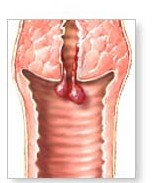 Polyps descend into the vaginal canal. |
Cervical PolypsContents • What Are Cervical Polyps? |
|
More Articles |
What Are Cervical Polyps?
A cervical polyp is a fingerlike fleshy growth on the cervix (the lower part of the womb that connects to the vagina). Polyps are usually reddish brown or gray-white in color. They can vary in size and often look like a bulb on a thin stalk (which is its blood supply). Polyps are quite small and only measure 1cm or 2cm long. Most women only have one polyp at a time, but it is not unusual to have two or three. Cervical polyps are hardly ever cancerous (less than 1 percent) but because some rare cancers can look like polyps, the polyp should be removed for biopsy. Additionally as polyps can produce symptoms similar to unrelated cervical cancer, a Pap Smear test is also carried out. Cervical polyps symptoms: In most cases, they do not cause symptoms. However, you may experience:
Doctors still do not fully understand the causes of cervical polyps. Suggested theories include: • Abnormal response to the female hormone estrogen. Estrogen may over stimulate the growth of cervical tissue. Cervical polyps rarely occur before menarche (the onset of periods). The condition is seen in about 4 percent of women of reproductive age and hormone changes in pregnancy can act as a stimulate for growth. Polyps are most common in women in their 40s and 50's approaching menopause, particularly in women who have had children. They tend to disappear after menopause. There are two types of cervical polyps: ectocervical and endocervical. Ectocervical develop in the outer surface of the cervix and are more common in postmenopausal women. Endocervical develop from the glands within the cervical canal and are more common in women of reproductive age. Endocervical growths tend to have a longer stalk. Ectocervical growths are usually wider and shorter.
Diagnosing cervical polyps is relatively easy because they are usually clearly visible during a pelvic examination. They appear red or purple with a smooth surface and protrude from the cervical canal. As the symptoms of cervical polyps resemble those of cervical cancer, the doctor will often perform a Pap smear test or a biopsy of cervical tissue to rule out malignancy. Once a diagnosis has been made you may be referred to a gynecologist or local hospital for treatment. How Are Cervical Polyps Treated? Treatment of cervical polyps: A polyp will sometimes shed on its own during menstruation or if knocked during sexual intercourse. However, most need to be removed as they tend to imbed and grow indefinitely. The treatment of cervical polyps is reasonably straight forward. Under local anesthesia the doctor uses a small forceps to twist the polyp off. While this sounds painful, it usually isn't because there are no nerves in the growth. Instead you may experience a slight tugging sensation which women who have had the procedure describe as a 'little uncomfortable'. Once the polyp is removed the doctor will check for any remaining signs of the base of the growth. If tissue remains it will be scrapped with a curette. Finally a surgical paste is applied to encourage healing. The polyp is sent to a pathology laboratory to check for signs of precancerous or cancerous cells. If the polyp turns out to be cancerous, the treatment will depend on the type and extent of cancer identified. Can Cervical Polyps Cause Infertility? Yes, polyps in the cervix have been linked to infertility - that is, if they grow large enough to block the entrance to the cervix or interfere with the production of cervical mucus. Fortunately fertility is easily restored by having the polyp removed. How Are Polyps Treated During Pregnancy? Cervical polyps in pregnancy are quite common - probably because of the hormone spikes the body goes through. Unless they grow so large that they block the cervix and cause problems for a vaginal birth, they are usually monitored and only treated once the baby is born (although some doctors feel it is safe to remove polyps at all stages of pregnancy). The main distress polyps cause during pregnancy is that they can cause bleeding which some moms-to-be understandably mistake for miscarriage. If the polyp remains symptomatic you may be offered treatment after month 6 into your pregnancy. However where possible, it is generally best to wait until after the baby is born to prevent aggravating the cervix. In the meantime you may be told to refrain from intercourse as this can irritate the polyp and cause it to bleed. Once removed cervical polyps tend not to grow back on the original site. However, they can occur in other parts of the cervix. For this reason, a regular pelvic examination is recommended so that new growths can be spotted and treated before they cause symptoms. To prevent cervical or vaginal infections linked to cervical polyps:
|
| Related Articles on Polyps
For more on gynecological problems, see the following: • Reproductive System Disorders Back to Homepage: Womens Health Advice |
|
WOMENS HEALTH ADVICE: ABOUT POLYPS |